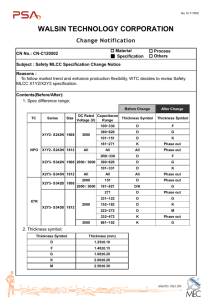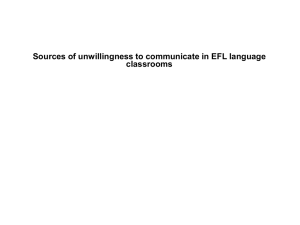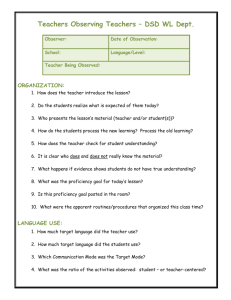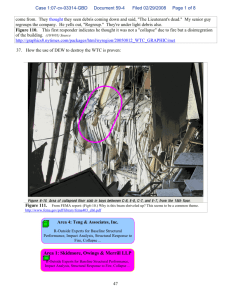Willingness to communicate in English among Japanese college
advertisement
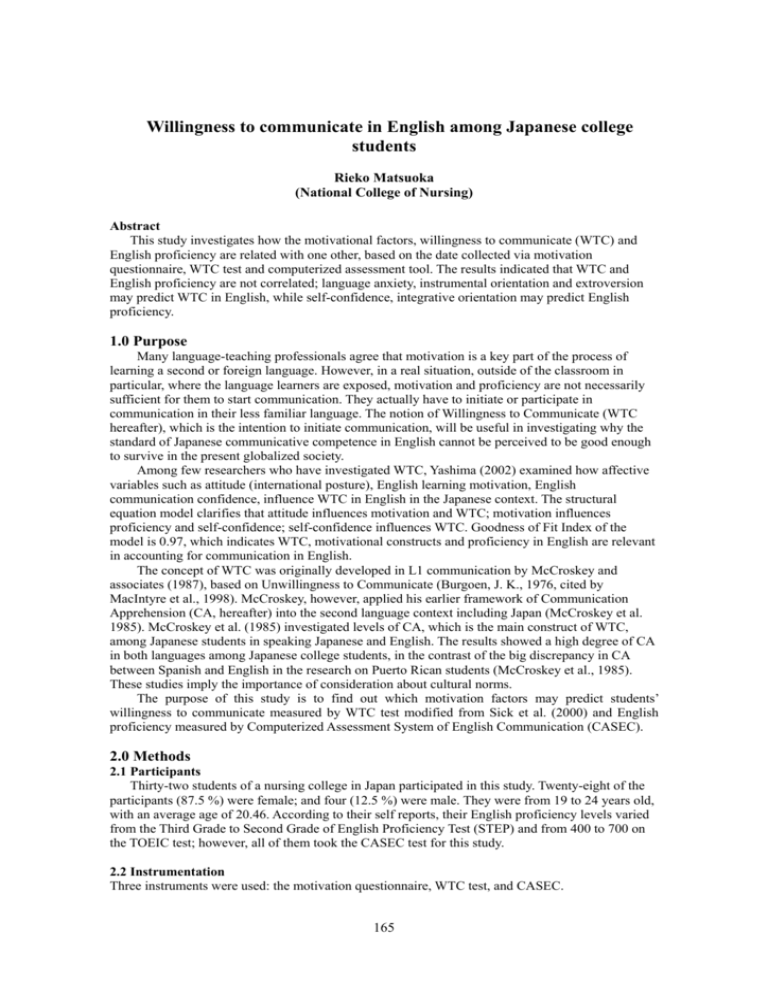
Willingness to communicate in English among Japanese college students Rieko Matsuoka (National College of Nursing) Abstract This study investigates how the motivational factors, willingness to communicate (WTC) and English proficiency are related with one other, based on the date collected via motivation questionnaire, WTC test and computerized assessment tool. The results indicated that WTC and English proficiency are not correlated; language anxiety, instrumental orientation and extroversion may predict WTC in English, while self-confidence, integrative orientation may predict English proficiency. 1.0 Purpose Many language-teaching professionals agree that motivation is a key part of the process of learning a second or foreign language. However, in a real situation, outside of the classroom in particular, where the language learners are exposed, motivation and proficiency are not necessarily sufficient for them to start communication. They actually have to initiate or participate in communication in their less familiar language. The notion of Willingness to Communicate (WTC hereafter), which is the intention to initiate communication, will be useful in investigating why the standard of Japanese communicative competence in English cannot be perceived to be good enough to survive in the present globalized society. Among few researchers who have investigated WTC, Yashima (2002) examined how affective variables such as attitude (international posture), English learning motivation, English communication confidence, influence WTC in English in the Japanese context. The structural equation model clarifies that attitude influences motivation and WTC; motivation influences proficiency and self-confidence; self-confidence influences WTC. Goodness of Fit Index of the model is 0.97, which indicates WTC, motivational constructs and proficiency in English are relevant in accounting for communication in English. The concept of WTC was originally developed in L1 communication by McCroskey and associates (1987), based on Unwillingness to Communicate (Burgoen, J. K., 1976, cited by MacIntyre et al., 1998). McCroskey, however, applied his earlier framework of Communication Apprehension (CA, hereafter) into the second language context including Japan (McCroskey et al. 1985). McCroskey et al. (1985) investigated levels of CA, which is the main construct of WTC, among Japanese students in speaking Japanese and English. The results showed a high degree of CA in both languages among Japanese college students, in the contrast of the big discrepancy in CA between Spanish and English in the research on Puerto Rican students (McCroskey et al., 1985). These studies imply the importance of consideration about cultural norms. The purpose of this study is to find out which motivation factors may predict students’ willingness to communicate measured by WTC test modified from Sick et al. (2000) and English proficiency measured by Computerized Assessment System of English Communication (CASEC). 2.0 Methods 2.1 Participants Thirty-two students of a nursing college in Japan participated in this study. Twenty-eight of the participants (87.5 %) were female; and four (12.5 %) were male. They were from 19 to 24 years old, with an average age of 20.46. According to their self reports, their English proficiency levels varied from the Third Grade to Second Grade of English Proficiency Test (STEP) and from 400 to 700 on the TOEIC test; however, all of them took the CASEC test for this study. 2.2 Instrumentation Three instruments were used: the motivation questionnaire, WTC test, and CASEC. 165 2.2.1 Motivation questionnaire The questionnaire was developed by the author (see Appendix A), based on the results of exploratory factor analysis of the data collected from 226 students, using 81 item-questionnaire. The 81 items from various resources in the previous studies (e.g., Gardner & Smythe, 1981, Yashima, 2002) was reduced to forty items which are answered on a Likert sale of 1 to 6. The most common step numbers have been five or six According to Dörnynei (2003), but six options was chosen in order to avoid the undecided category, which Japanese people are inclined to choose. The contact email address and thank-you note is added, following to Dörnyei’s advice (2003). The exploratory factor analysis generated eight factors marking over 5.0 loading. These factors are named integrativeness, anxiety, self-confidence, attitudes, motivational intensity: effort, instrumentality, intrinsic motivation, and personal trait and made subscales for analysis. The previous studies on motivation (e.g., Gardner, 1980; Garnder & Smythe, 1981: Yashima, 2002) did not include ‘intrinsic motivation’ and extrinsic motivation was added where ‘intrinsic motivation’ was included (e.g., Noels et al, 1999), based on the Deci & Ryan’s determination theory (1985). However, I believe that both integrativeness and instrumentality in terms of motivational orientation should be regarded as extrinsic; therefore, intrinsic motivation should be added to intergrativeness and instrumentality. The factory analysis indicated there might exist the factor implying the intrinsic motivation. All these subscales for motivational variables gained a reasonable reliability value of Cronbach α, except for ‘personal trait’, which has only one item. However, ‘personal trait’ is included as a gauge of ‘extroverted-ness’, which may turn out to be an important predictor for WTC. 2.2.2. WTC test Following the belief that WTC, rather than English proficiency, should be the ultimate goal of language learning posited by MacIntrye and associates (e.g., 1998), Sick (2001) suggested that WTC makes an interesting candidate as an object of assessment. Sick stated that a WTC test has a face-validity, i.e., ‘what good is competent L2 speaker who is unwilling to make use of his/her competence?’ It also incorporates a variety of other affective and social variables, and can be viewed as a shortcut to assessing several other variables of interest. Sick proposed five conditions necessary or desirable for WTC to be a viable object of assessment. First, being informative and them moderately stable, which means not too stable nor not too unstable. The third condition is being reliable and the forth is being valid and the last one is to have positive backwash. The WTC test that Sick and his colleague developed has 41 items from four conceptual types, which are in-class speaking, in-class writing, out-of-class speaking and out-of-class writing. Since this study focuses on speaking, I eliminated the writing activities. Some items are modified according to the given context of nursing. As the result, the numbers of items reduced into 29. For each item, three rating, that are confidence, anxiety and willingness are assigned with four likert scales. Sick’s original test has ten-likert scales (0-9) but he advised me that four scales (0-3) turned out to be more useful. Therefore, four scales are used for 29 items with 3 rating in this study (See Appendix B). The value of Cronbach α of this test was .88, which endorsed the reliability. 2.2.3 CASEC (Computerized assessment system of English communication) CASEC is the Computerized Assessment System for English Communication originally developed by The Society for Teaching English Proficiency, Inc. (STEP, hereafter). STEP, which is the largest testing institution in Japan, spent more than seven years for fundamental research of its development. At present, The Japan Institute for Research on Testing, Inc. (JIEM, hereafter) took over the operation and research on CASEC. JIEM was established in 2000 as an Obunsha Group company and has taken responsibilities of activities related to the research and development of accurate measuring techniques or testing in the field of education (http://casec.evidus.com/hojin/english.html). Individual English communication ability is assessed by utilizing a system of computerized adaptive testing (CAT). Item response theory (IRT), which is one of the latest testing theory, enables this system to assess an individual’s proficiency accurately and objectively, according to JIEM. More specifically, the difficulty level changes, depending on whether a test taker answers the previous question correctly or incorrectly. Because of this system, the test takers do not have to take questions that would be too easy or difficult for them. This testing system also enables the testing time to be shorter than other standardized test such as TOEIC which requires two hours. The testing time 166 ranges from 20 minutes to 70 minutes and 40 minutes is average according to the report by JIEM. Even with this absolute evaluation system, the CASEC test can evaluate the test takers relatively as well. The details will be explained in the following section. Section 1 is for vocabulary knowledge. There are fifteen questions and asking form is 4-option multiple choice. Total point is 250 and time limit is 60 seconds per question. Section 2 is for checking the knowledge of idioms and useful expressions. There are also fifteen questions in the form of four-option multiple choices. Total point is 250 which is the same as Section 1 but time limit is 90 seconds per question, which is 30 seconds longer than the section 1. Section 3 is a listening test, with the purpose of grasping the main point. There are also 15 questions with 4-option multiple choices. The total point is also 250 and time limit is 60 seconds, which is the same as a vocabulary section (section 1). Section 4 is a dictation test consisting of ten questions.. The test takers input the words using keyboard. Total points are also 250 and time limit per question is 120 seconds. Since the individual test taker processes the test, the time spent is varied from 20 minutes to 70 minutes from the beginning of test to the indication of the test score. The approximate average time is 40 minutes. The institute operating CASEC (JIEM. Inc. 2004) reported that the contents of CASEC test are rationalized to gain validity as a system of testing English communicative proficiency via internet. In order to measure the English proficiency, the CASEC test, which is easily accessible to the students, is quite promising tool and I decided to use this system to measure the English proficiency level for my students. According to the periodical report in PDF format, the number of test takers is getting larger since they started this testing service in 2002. As of July, 2004, approximately one hundred twenty thousand people including college students and company employees are taking CASEC in total. The items of questions stored for this system also increased; from 2000 to more than 4000. The researchers at JIEM keep on improving the quality of this system, judging from the personal communication with a senior researcher (June, 2004). Using CASEC as a gauging tool of English proficiency of the participants for my research seems to be legitimate. 3.0 Results and discussion Pearson correlation with significance two-tailed (p<.05) was performed with motivational variables WTC, and English proficiency. The motivational variables included (a) integrativeness, (b) instrumentality, (c) anxiety, (d) self-confidence, (e) motivational intensity: effort, (f) intrinsic motivation, and (g) personal trait. English proficiency was composed of (a) vocabulary, (b) idioms, (c) listening, and (d) dictation. No significant correlation was not produced between WTC and English proficiency, which means WTC and English proficiency are not related with each other. This result endorsed the anecdotal data that some proficient learners of English are reluctant to speak English and some less proficient learners of English are willing to speak English. Previous studies on WTC in an L2 (e.g., Yashima, 2002) also found out no direct relatedness between English proficiency and WTC, employing the structural equation model. Her results indicated that motivation influences English proficiency and self-confidence, and self-confidence influences WTC; however, English proficiency itself has no influence over WTC. The significant correlation coefficient (r> .3) was produced only in the following items: WTC: anxiety (-.65), confidence (.55), attitudes (.34), trait (.46); Proficiency: Vocabulary: confidence (.53), Listening- intergrativeness (.36), confidence (.52), attitude (.38), effort (.46) Dictation – integrativeness (.51), confidence (.49), effort (.46) instrumentality (.42). Total (Vocabulary, Idioms, Listening, Dication): integrativeness (.58), confidence (.49), effort (.46), instrumentality (.42) As indicated above, WTC was correlated to anxiety, attitude, and trait but not related to any proficiency subscales. Among the motivational variables, either integartivity and instrumentality did 167 not have any relatedness to WTC; attitude, intrinsic motivation and effort did also have no relatedness to WTC. These results indicate that the learners may not have high level of WTC even in the case that they are motivated extrinsically or intrinsically and have positive attitudes toward English people and culture and try hard to improve English. This contradicts partially Yashima’s comprehensive study using structural equation model (2002) which showed the reasonable amount of influence from ‘international posture’, which corresponds to attitude in this study, to WTC in English. On the other hand, English proficiency and several motivational variables were found out to be correlated, though the subscale of ‘idioms’ had no relationship with any variables. Among four subscales in English proficiency, listening and dictation showed some relatedness with motivational variables. The research done by JIEM which found out the strong relatedness of dictation and listening to the speaking competency may explain this result. In the case of dictation, when the learners are motivated both integratively and instrumentally, make much effort and have a high level of confidence, they are good at dictation and also good at speaking. Here being good at speaking English does not necessarily cause WTC or the other way around. WTC is more psychological construct than linguistic proficiency. Then the stepwise multiple regressions were performed with both WTC and English proficiency as a dependent variable. The results are as follows: Table 1 The result of Stepwise Multiple Regression (WTC) Model R R Square Adjusted R Square Std. Error of the Estimate 1 .647(a) .418 .398 28.63536 2 .750(b) .563 .531 25.26975 3 .802(c) .643 .603 23.24368 Table 2 a . Predictors: (Constant), anxiety b. Predictors: (Constant), anxiety, instrumentality The result of Stepwise Multiple trait Regression c . Predictors: (Constant), anxiety, instrumentality, d.Dependent Variable: WTC Model R R Square Adjusted R Square Std. Error of the Estimate 1 .521(a) .272 .247 53.76668 2 .654(b) .427 .386 48.53141 As the above tables show, the level of anxiety can predict WTC the most, the instrumentality a. Predictors: (Constant), confidence the next and the trait the third; whereas the confidence can predict the English proficiency the most b. Predictors: confidence, and the integrativity is the (Constant), sub-predictor. Theseintegrativity imply that to lower the anxiety level raises their WTC, which has been proved by bunch of research c. Dependent Variable: English proficiency on WTC both in an L1 and an L2 (e.g., McCroskey, 1997; MacIntyre, et al., 2001); however, the studies (e.g., MacIntyre et al., 1996) showed the influence from anxiety to WTC was indirect; that is, anxiety influences negatively self-confidence, which, in turn, positively influences WTC. In other words, the learners have a lower level of anxiety or apprehension in an L2, they have a higher level of self-confidence or higher level of perceived competence in an L2; consequently, they have a higher level of WTC. The instrumentality or the necessity of speaking English also may help the learners to enhance their WTC. When the learners have pragmatic orientations, they present higher level of WTC. The trait, which is the main factor in determining the WTC in L1, also functions as a predictor. More specifically, the extroversion is one of the important factors in the WTC in L2 as well. The Pearson correlation does not produce a significant correlation coefficient between WTC and English proficiency; however, the stepwise multiple regression analysis indicates the confidence predicts the WTC. According to some literature (e.g., Clément, 1980), the confidence is defined as the lack of anxiety. It is not always true but the confidence and anxiety are certainly related. The instrumentality and integrativenss also reveal the interesting contrast. The instrumentality may predict or influence the WTC: while the itnegrativeness may predict or influence the English 168 proficiency. As stated earlier, intrinsic motivation is treated as a separate subscale in this study, based on the belief that both integrativeness and instrumentality are regarded as extrinsic motivation because both are generated by the extraneous factors. Lastly, it must be noted that the intrinsic motivation did not present any relatedness or was not found out to be a predictor of either WTC or English proficiency. This may be translated into as follows in the actual learning context. We humans are not very strongly willed. When we have some specific orientations to motivate ourselves whether they are integrative or instrumental, we do not invest ourselves in language learning even in the case we are very much interested in an L2. In order to enhance WTC and/or English proficiency, we may need to have some specific reason(s) to drive ourselves forward. 4.0 Conclusion (Summery) Despite the small sample in this study, the results indicated several interesting relatedness among motivational variables, WTC, and English proficiency, which have been investigated in previous research on WTC in both an L1 and L2 (e.g., McCroasky, 1997). Among them, the most important in language learning is that WTC is not directly related to English proficiency and language anxiety predicts WTC, instead. The teaching professions should be aware of the fact that lowering the level of anxiety in English learning context will enhance WTC. As some research have indicated (MacIntyre, 1996), language anxiety/apprehension may not be directly related to WTC but via self-confidence, which is also very much closely related to or even overlaps with anxiety. Improving English proficiency should be regarded as important in language learning but raising the level of WTC may be more urgent in order for Japanese learners of English to be active in this borderless world where English is must. The future study with a larger sample will clarify the underlying structure of WTC in the relations with other factors such as motivational variables and English proficiency. REFERENCES Baker, S. C, & MacIntyre, P. D. (2003). The role of gender and immersion in communication and second language orientations. In Dörnyei (Ed.), Attitudes, orientations and motivation in language learning (pp. 65-96). Oxford: Blackwell. Brown, J. D., Robson, G., & Rosenkjar, P. R. (2001). Personality, motivation, anxiety, strategies, and language proficiency of Japanese students. In Z. Dörnyei & R. Schmidt (Eds.), Motivation and second language acquisition (pp. 361-398). Honolulu: University of Hawai’i Press. Chappelle, C. A. (2001). Computer applications in second language acquisition. Cambridge: Cambridge University Press. Clément, R. (1980). Ethnicity, contact and communicative competence in a second language. In H. Giles, W. P. Robinson, & P. M. Smith (Eds.), Language: Social psychological perspectives (pp. 147-154). Oxford: Pergamon. Deci, L., & Ryan, M. (1985). Intrinsic motivation and self-determination in human behavior. New York: Plenum. Dörnyei, Z. (2003). Attitudes, orientations, and motivations in language learning: Advances in theory, research and applications. In Z. Dornyei (Ed.), Attitudes, orientations and motivation in language learning (pp. 3-32). Oxford: Blackwell. Dörnyei, Z. (2003). Questionnaires in second language research: Construction, administration, and processing. Mahwah, N.J.: Lawrence Erlbaum. Gardner, R. C. (1980). On the validity of affective variables in second language acquisition: conceptual, contextual, and statistical considerations. Language Learning, 30, 255-270. 169 Gardner, R. C., & Smythe, P. C. (1981). On the development of the Attitude/Motivation Test Battery. The Canadian Modern Language Review, 37, 510-525. Hayashi, N. (2004). Keishikikettei sample test mondairei [Sample tests for deciding the testing formats]. Japan Institute for Educational Measurement (2002). Selection(Senbetsu) kara Placement(kobetsu)e [From selection to placement] Japan Institute for Educational Measurement 1-3. Japan Institute for Educational Measurement (2004). The computerized assessment system for English communication (CASEC). http://casec.evidus.com/hojin/english.html 1-2. Kimura, Y., Nakata, Y., & Okumura, T. (2001). Language learning motivation of EFL learners in Japan: A cross-sectional analysis of various learning milieus. JALT Journal, 23, 47-68. MacIntyre, P. D. (1994). Variables underlying willingness to communicate: A causal analysis. Communication Research Reports, 11, 135-142. MacIntyre, P. D., Baker, S. C., Clement, R., & Conrod, S. (2001). Willingness to communicate, social support, and language-learning orientations of immersion students. Studies in Second Language Acquisition 23, 369-388. MacIntyre, P. D., Baker, S. C., Clement, R., & Donovan, L. A. (2003a). Sex and age effects on willingness to communicate, anxiety, perceived competence, and L2 motivation among junior high school French immersion students. In Z. Dörnyei (Ed.), Attitudes, orientations, and motivation in language learning (pp. 137-165). Oxford: Blackwell. MacIntyre, P. D., Baker, S. D., Clement, R., & Donovan, L. A. (2003b). Talking in order to learn: Willingness to communicate and intensive language programs. The Canadian Modern Language Review, 54(4), 589-607. MacIntyre, P. D., & Charos, C. (1996). Personality, attitudes, and affect as predictors of second language communication. Journal of Language and Social Psychology 15, 3-26. MacIntyre, P. D., Clément, R., Dornyei, Z., & Noels, K. (1998). Conceptualizing willingness to communicate in a L2: A situational model of L2 confidence and affiliation. The Modern Language Journal, 82, 545-562. MacIntyre, P. D., Babin, P. A., & Clément, R. (1999). Willingness to communicate: Antecedents and consequences. Communication Quarterly, 47, 215-229. Maruzenkabushikigaisha kankyo design jigyoobu [Maruzen environmental design project department] (2003). Internet o riyoshita kojintekiogata eigo communication noryokutest no goteian [Proposal of computerized assessment system for English Communication]. MARUZEN, 1-14. Maruzenkabushikigaisha kankyo design jigyoobu [Maruzen environmental design project department](2003). Hokano test tono sokanbunpu shiryo [Correlation with other tests and scatter plot]. MARUZEN, 1-3. McCroskey, J. C. (1984). The communication apprehension perspective. In J. A. Daly, & J. C. McCroskey (Eds.), Avoiding communication: Shyness, reticence, and communication (pp. 81-94). Beverly Hills, CA: Sage. McCroskey, J. C. (1992). Reliability and validity of the willingness to communicate scale. Communication Quarterly, 40, 16-25. McCroskey, J. C. (1997). Willingness to communicate, communication apprehension, and 170 self-perceived communication competence: conceptualizations and perspectives. In Daly, & J. C. McCroskey (Eds.), Avoiding communication: Shyness, reticence, & communication apprehension (pp. 75-108). Cresskill, NJ: Hampton Press. McCroskey, J. C., Fayer, J. M., & Richmond, V. P. (1985). Don’t speak to me in English: Communication apprehension in Puerto Rico. Communication Quarterly, 33(3), 185-192. McCroskey, J. C., Gudykunst, W. B., & Nishida, T. (1985). Communication apprehension among Japanese students in native and second language. Communication Research Reports, 2, 11-15. McCroskey, J. C., & Richmond, V. P. (1990). Willingness to communicate: Differing cultural perspectives. Southern Communication Journal, 56, 72-77. Noels, A. Clément, R., & Pellietier, G. (1999). Perceptions of teachers’ communicative style and students’ intrinsic and extrinsic motivation. Modern Language Journal, 83, 23-34. Sick, J. R., & Nagasaka, J. P. (2000). A test of your willingness to communicate in English (Japanese version): Unpublished questionnaire. Sick, J. R. (2001, August). Willingness to communicate as an object of classroom assessment. Paper presented at the annual convention of PacSLRF, Hawaii. SPSS 12.0 for Windows (2003). [Computer software], Chicago: SPSS Inc. Tabachnick, G.., & Fidell, S. (2001). Using multivariate statistics, 4th ed. Boston: Allyn and Bacon. Wen, W. P., & Clement, R. (2003). A Chinese conceptualization of willingness to communicate in ESL. Language, Culture and Curriculum, 16, 18-38. Yashima, T. (2002). Willingness to communicate in a second language: The Japanese EFL context. The Modern Language Journal, 86, 54-66. Yashima, T., Zenuk-Nishide, L., & Shimizu, K. (2004). The influence of attitudes and affect on willingness to communicate and second language communication. Language Learning, 54, 119-152. 171 APPENDIX A MOTIVATION QUESTIONNAIRE 英語を話そうとする気持ち(Willingness to communicate in English)について研 究するためのアンケートで、英語の会話力を伸ばす指導に役立てるためのもの です。CASEC の受験もお願いします。宜しくご協力ください。 This questionnaire is for research on willingness to communicate in English, which I hope will improve teaching English speaking ability. I also ask you to take CASEC.I really appreciate your cooperation. 学籍番号 ID#( ) 氏名 Name ( ) 性別 Gender(女性 female・男性 male) 年齢 age( ) 英語圏の国での滞在 Experience of staying in an English-speaking country (有 Yes・無 No)ある場合の期間 If yes, from when to when ( 年 月から 年 月) 英語力 English Proficiency 英検 Step: TOEIC: TOEFL CASEC http://casec.evidus.com/ → 団体受験 Follow-up interview に応じてくれる場合は、連絡方法を教えてください。 If you accept a follow-up interview, please provide a contact number. ( ) 以下の項目について、次の尺度に従い、番号で答えてください。 Please answer the items by the number specified in the scale below. 6 強くそう思う。 (Strongly agree) 5 そう思う。 (Agree) 4 僅かにそう思う。 (Partly agree) 3 僅かにそう思わない。(Slightly disagree) 2 そう思わない。 (Disagree) 1 強くそう思わない。 (Strongly disagree) ( ( ( ( ( ) 1.自分の話した英語が相手に通じないとあせる。 I am panicked when I cannot make myself understood in English. ) 2.他の学生と比較して英語の勉強を熱心にしていると思う。 I think I study English harder than other students. ) 3.英語のクラスで学んだことについてよく考える。 I frequently think over what I have learnt in my English class. ) 4.他の学生の上手な英語を聞くとあせる。 I feel worried when I hear other students speaking good English. ) 5.英語の宿題が課される場合、即仕上げることに努めている。 When I have assignments to do in English, I try to do them immediately. 172 ( ( ( ( ( ( ( ( ( ( ( ( ( ( ( ( ( ( ( ( ( ( ( ( ( ( ( ) 6.英語の授業がなくても、自分で勉強するようにすると思う。 If English were not taught at college, I would study it on my own. ) 7. 英語で意見を述べる場合、言いたいことがあっても控えることがある。 Even when I have an opinion, I refrain myself verbalizing it in English. ) 8.英語の勉強に結構時間を費やしている。I spend long hours studying English. ) 9.自分は社交的だと思う。 I am extrovert. ) 10.英語の授業に集中し、熱心に取り組んでいる。 During English classes I am absorbed in what is taught and concentrate on my studies. ) 11.大学で英語を教わるのは当然だと信じている。 I absolutely believe English should be taught at school. ) 12.英語の世界について学びたいと思う。 I would like to learn about the English world. ) 13.英語を話して恥をかくより黙っているほうかよい。 I prefer being silent rather than being embarrassed in speaking English. ) 14.自分の英語のレベルが他の学生より低いのだろうかと心配になる。 I worry that my English proficiency is worse than other students. ) 15.地元で仕事をする方がいい。 I would rather work in my hometown. ) 16.できれば外国に住みたい。 I would like to live in a foreign country. ) 17.WHO のような国際的な組織で働きたい。 I want to work in an international organization such as WHO. ) 18.海外に頻繁に行くような仕事は避けたい。 I would rather avoid the kind of work that sends me overseas frequently. ) 19.一対一の会話は、英語でできると思う。 I can speak English in one-to-one conversation in English. ) 20.英語が得意だと思う。 I think I am good at English. ) 21.教養を高めるために、英語を学んでいる。 I learn English to be more knowledgeable. ) 22.英語圏の人と英語で話せないと恥ずかしいと思う。 I would feel ashamed if I couldn’t speak to native speakers in English. ) 23.英語に限らず外国語を習得する才能があると思う。 I have an aptitude in learning foreign languages. ) 24.英語圏の人と結婚したいと思う。 I would like to get married to an English-speaking person. ) 25.授業以外教員に質問したり話し掛けたりする。 I ask English teachers questions or talk to them outside the class period. ) 26.大学以外で友人や知り合いと英語で話すことがある。 I talked with friends or acquaintances outside school in English. ) 27.将来、国際医療の現場で活躍したい。 I hope to be active in the international heath services later on. ) 28.ネイティブの前で話すと緊張する。 I feel nervous in speaking English in front of a native speaker. ) 29.私の英語力は一般的な日本人より優れていると思う。 My English proficiency is superior to other Japanese ones in general. ) 30.英語圏の人と友達になりたい。 I would like to make friends with English speaking people. ) 31.英語圏の国に行っても、英語で困ることはないと思う。 I think I will have no problem when I visit English-speaking countries. ) 32.将来、成功するためには英語が必要だと思う。 173 ( ( ( ( ( ( ( ( English is a must for me to succeed in the future. ) 33.英語を話すと下手だと思われるのではないかと不安になる。 I feel worried other people may think I am a poor speaker of English in speaking English. ) 34.英語を聞いたり話したりするとワクワクする。 I have ‘high’ feeling when hearing or speaking English. ) 35.英語を話していて単純な間違えをすると恥ずかしく感じる。 I feel embarrassed when I make a simple mistake in speaking English. ) 36.英国人に対して好印象をもっている。 I have a favorable impression towards British people. ) 37.学校以外で英語の学習を行っている。I learn English off campus. ) 38.条件が揃えば、英語圏に留学したいと思っている。 I would like to study abroad if possible. ) 39.米国人に対して好印象をもっている。 I have a favorable impression towards American people. ) 40.これからの日本の社会では英語を話すことは必須であると思う。 I think speaking English is required in Japan from now on. *ご協力、ありがとうございました。Thank you very much for your cooperation. Rieko Matsuoka (matsuokar@adm.ncn.ac.jp) 174 APPENDIX B A Test of Your Willingness to Communicate in English 自信 名前: 緊張 やる気 3 簡単にできると思う 3 すごく緊張する 3 2 たぶんできると思う 2 かなり緊張する 2 1 あまりできないと思う 1 すこしは緊張する 1 0 絶対できないと思う 0 ぜんぜん緊張しない 0 是非やってみたい 機会があれば、 やってみたい 場合によりけり できれば避けたい つぎのような英語を使う機会があったとして、それぞれの行動についての「自信」、「緊張度」、「やる気」を 0―3 段階であらわして下 さい。「自信」とはその時、英語を的確に使う自信があるかないかを、「緊張度」はとても緊張するかあるいはしないか、「やる気」はそ ういう機会があったらすすんでするか、あってもしない、避けるかを答えてください。 自 信 1 日本人の先生にテープのダビングをたのむ。 2 3 4 リスニングテストのテープが速すぎて聞き取れなかったと日本人の教師に文句を言う。 5 英語圏の国のホテルを予約するために電話をかける。 6 学校新聞の記事のため ネイティヴの先生にインタヴューする。 7 ペアワークの相手に今何時か聞く。 8 電車で隣に座った外国人に声をかける。 9 ネイティヴの先生に単語の意味をきく。 10 英語しかできない友達をパーティーに招待する電話をかける。 11 ネイティヴの先生に休んでいた間のプリントが欲しいと言う。 12 ペアワークの相手に自分が見たテレビ番組について話す。 13 クラス全員に対して自分が見たテレビ番組について立って話す。 14 レストランでメニューが読めず困っている様子の外国人を助けてあげる。 15 時間がわからないとき外国人に時間をたずねる。 16 スーパーで店員の言うことが分からず困っている様子の外国人を助けてあげる。 17 18 アメリカから本校を訪問しにきた医療専門家のグループに学校を代表して歓迎の挨拶を する。 休み中の旅行についてネイティヴの先生の質問に前に出て答える。 19 クラス全員に対して2分間、自分の夏休みの思い出について立って話す。 20 21 海外でしか売っていないレアものの CD を通販で買うためにアメリカの CD 店に電話で注文 する 英語圏の国から来た小人数の団体を東京一日観光に連れて行く。 22 ホストファミリーに電話をかけて滞在させてくれることに礼を言う。 23 ペアワークの相手にある場所への行き方を地図を使って教える。 24 ペアワークの相手に S で始まる英単語を5つ言う。 25 ネイティヴの先生にテープのダビングをたのむ。 リスニングテストのテープが速すぎて聞き取れなかったとネイティヴの教師に文句を言う。 日本の学生生活についてアメリカのテレビの取材にこたえる。 175 緊 張 やる気 自 信 26 日本人の先生にクラスルーム・イングリッシュを使って単語の意味をきく。 27 クラス全員に対して T で始まる英単語を5つ立って言う。 28 ペアワークの相手に2分間、自分の夏休みの思い出について話す。 29 駅で困っている様子の外国人を助けてあげる。 30 日本人の学生対象の英語スピーチコンテストに出場する。ジャッジはネイティヴスピーカ ー。 緊 張 やる気 Modified from Sick et al. (2002) 176


